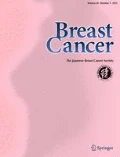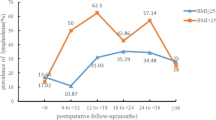Abstract
Purpose
To investigate the incidence rate, severity and risk factors of related lymphedema in breast cancer survivors.
Methods
A 2-year follow-up prospective study of 387 women who had operation from four hospitals from January 1, to December 31, 2014 was conducted. Limb volume was measured by circumference and symptoms were measured using questionnaires pre-treatment and 1, 3, 6, 12, 18, 24 months after surgery separately. The incidence rates and the severity of lymphedema were evaluated, respectively. Risk factors for the development of breast cancer-related lymphedema (BCRL) were analyzed using log-rank test and Cox regression.
Results
The incidences of BCRL were 4.4, 10.1, 15.2, 28.6, 31.2 and 32.5% at 1, 3, 6, 12, 18, 24 months after surgery, respectively, measured by Norman questionnaire. The rates measured by arm circumference were 2.5, 6.7, 13.4, 21.4, 26.3 and 29.4%, respectively. About 114 (29.4% of 387) women were diagnosed with BCRL, and 78 of them got mild lymphedema. Axillary lymph node dissection (ALND) (HR = 5.2, 95% CI 1.6–17.3), radiotherapy (HR = 3.9, 95% CI 2.0–7.5), modified radical mastectomy (MRM) (HR = 2.1, 95% CI 1.3–3.4), the number of positive lymph nodes (HR = 1.1, 95% CI 1.0–1.2) and body mass index (BMI) (HR = 1.1, 95% CI 1.0–1.1) were independent risk factors for BCRL.
Conclusions
BCRL is a common complication for breast cancer patients after surgery. It can be fairly diagnosed only 1 month post-operation and the cumulative incidence of BCRL seems to be increasing over time, especially in the first year after surgery. ALND, radiotherapy, MRM, the number of positive axillary lymph nodes and BMI were found to be independent risk factors in the development of BCRL in this study.

Similar content being viewed by others
References
McLaughlin SA, Bagaria S, Gibson T, et al. Trends in risk reduction practices for the prevention of lymphedema in the first 12 months after breast cancer surgery. J Am Coll Surg. 2013;216(3):380–9.
Fu MR, Ridner SH, Hu SH, et al. Psychosocial impact of lymphedema: a systematic review of literature from 2004 to 2011. Psychooncology. 2013;22(7):1466–84.
Fu MR, Kang Y. Psychosocial impact of living with cancer-related lymphedema. Semin Oncol Nurs. 2013;29(1):50–60.
Han JW, Seo YJ, Choi JE, et al. The efficacy of arm node preserving surgery using axillary reverse mapping for preventing lymphedema in patients with breast cancer. J Breast Cancer. 2012;15(1):91–7.
Armer JM, Stewart BR. Post-breast cancer lymphedema: incidence increases from 12 to 30 to 60 months. Lymphology. 2010;43(3):118–27.
Deutsch M, Land S, Begovic M, et al. The incidence of arm edema in women with breast cancer randomized on the National Surgical Adjuvant Breast and Bowel Project study B-04 to radical mastectomy versus total mastectomy and radiotherapy versus total mastectomy alone. Int J Radiat Oncol Biol Phys. 2008;70(4):1020–4.
Asim M, Cham A, Banerjee S, et al. Difficulties with defining lymphoedema after axillary dissection for breast cancer. N Z Med J. 2012;125(1351):29–39.
Pavy JJ, Denekamp J, Letschert J, et al. EORTC Late Effects Working Group. Late effects toxicity scoring: the SOMA scale. Radiother Oncol. 1995;35(1):11–5.
Norman SA, Localio AR, Kallan MJ, et al. Risk factors for lymphedema after breast cancer treatment. Cancer Epidemiol Biomark Prev. 2010;19(11):2734–46.
Stanton AW, Modi S, Mellor RH, et al. A quantitative lymphoscintigraphic evaluation of lymphatic function in the swollen hands of women with lymphoedema following breast cancer treatment. Clin Sci (Lond). 2006;110(5):553–61.
Czerniec S, Ward L, Refshauge K, et al. Assessment of breast cancer-related arm lymphedema-comparison of physical measurement methods and self-report. Cancer Invest. 2010;28(1):54–62.
Armer JM, Stewart BR. A comparison of four diagnostic criteria for lymphedema in a post-breast cancer population. Lymphat Res Biol. 2005;3(4):208–17.
Shah C, Vicini FA, Arthur D. Bioimpedance spectroscopy for breast cancer related lymphedema assessment: clinical practice guidelines. Breast J. 2016;22(6):645–50.
Seward C, Skolny M, Brunelle C, et al. A comprehensive review of bioimpedance spectroscopy as a diagnostic tool for the detection and measurement of breast cancer-related lymphedema. J Surg Oncol. 2016;114(5):537–42.
Fu MR, Cleland CM, Guth AA, et al. L-dex ratio in detecting breast cancer-related lymphedema: reliability, sensitivity, and specificity. Lymphology. 2013;46(2):85–96.
Lopez Penha TR, Slangen JJ, Heuts EM, et al. Prevalence of lymphoedema more than five years after breast cancer treatment. Eur J Surg Oncol. 2011;37(12):1059–63.
Hayes S, Sipio TD, Rye S, et al. Prevalence and prognostic significance of secondary lymphedema following breast cancer. Lymphat Res Biol. 2011;9(3):135–41.
Hayes SC, Janda M, Cornish BH, et al. Lymphedema secondary to breast cancer: how choice of measure influences diagnosis, prevalence, and identifiable risk factors. Lymphology. 2008;41(1):18–28.
DiSipio T, Rye S, Newman B, et al. Incidence of unilateral arm lymphoedema after breast cancer: a systematic review and meta-analysis. Lancet Oncol. 2013;14(6):500–15.
Norman SA, Localio AR, Potashnik SL, et al. Lymphedema in breast cancer survivors: incidence, degree, time course, treatment, and symptoms. J Clin Oncol. 2009;27(3):390–7.
Paskett ED, Naughton MJ, McCoy TP, et al. The epidemiology of arm and hand swelling in premenopausal breast cancer survivors. Cancer Epidemiol Biomark Prev. 2007;16(4):775–82.
Lucci A, McCall LM, Beitsch PD, et al. Surgical complications associated with sentinel lymph node dissection (SLND) plus axillary lymph node dissection compared with SLND alone in the American College of Surgeons Oncology Group Trial Z0011. J Clin Oncol. 2007;25(24):3657–63.
Vieira RA, da Costa AM, de Souza JL, et al. Risk factors for arm lymphedema in a cohort of breast cancer patients followed up for 10 years. Breast care (Basel, Switz). 2016;11(1):45–50.
Giuliano AE, Hunt KK, Ballman KV, et al. Axillary dissection vs no axillary dissection in women with invasive breast cancer and sentinel node metastasis: a randomized clinical trial. JAMA. 2011;305(6):569–75.
Nesvold I-L, Dahl AA, Løkkevik E, et al. Arm and shoulder morbidity in breast cancer patients after breast-conserving therapy versus mastectomy. Acta Oncol. 2008;47(5):835–42.
Warren LE, Miller CL, Horick N, et al. The impact of radiation therapy on the risk of lymphedema after treatment for breast cancer: a prospective cohort study. Int J Radiat Oncol Biol Phys. 2014;88(3):565–71.
Crosby MA, Card A, Liu J, et al. Immediate breast reconstruction and lymphedema incidence. Plast Reconstr Surg. 2012;129(5):789e–95e.
Gärtner R, Jensen M-B, Kronborg L, et al. Self-reported arm-lymphedema and functional impairment after breast cancer treatment—a nationwide study of prevalence and associated factors. Breast. 2010;19(6):506–15.
Zhu YQ, Xie YH, Liu FH, et al. Systemic analysis on risk factors for breast cancer related lymphedema. Asian Pac J Cancer Prev. 2014;15(16):6535–41.
Geller B, Vacek P, O’Brien P, et al. Factors associated with arm swelling after breast cancer surgery. J Womens Health (Larchmt). 2003;12(9):921–30.
Funding
This study was supported by Jiangsu Province’s Key Medical Department in 2011 (No. 201112) and Jiangsu Province Health Department Research Project (No. z201305).
Author information
Authors and Affiliations
Corresponding author
Ethics declarations
Conflict of interest
The authors declare that they have no competing interest.
Additional information
Li Zou and Feng-hua Liu are co-first authors.
About this article
Cite this article
Zou, L., Liu, Fh., Shen, Pp. et al. The incidence and risk factors of related lymphedema for breast cancer survivors post-operation: a 2-year follow-up prospective cohort study. Breast Cancer 25, 309–314 (2018). https://doi.org/10.1007/s12282-018-0830-3
Received:
Accepted:
Published:
Issue Date:
DOI: https://doi.org/10.1007/s12282-018-0830-3




